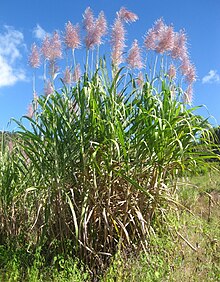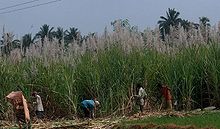Saccharum officinarum
| Saccharum officinarum | |
|---|---|

| |
| Saccharum officinarum growing in Mozambique | |

| |
| Harvesting sugarcane by hand | |
| Scientific classification | |
| Kingdom: | Plantae |
| Clade: | Tracheophytes |
| Clade: | Angiosperms |
| Clade: | Monocots |
| Clade: | Commelinids |
| Order: | Poales |
| Family: | Poaceae |
| Subfamily: | Panicoideae |
| Genus: | Saccharum |
| Species: | S. officinarum
|
| Binomial name | |
| Saccharum officinarum | |
Saccharum officinarum is a large, strong-growing species of grass in the sugarcane genus. Its stout stalks are rich in sucrose, a disaccharide sugar which accumulates in the stalk internodes. It originated in New Guinea,[1] and is now cultivated in tropical and subtropical countries worldwide for the production of sugar, ethanol and other products.
S. officinarum is one of the most productive and most intensively cultivated kinds of sugarcane. It can interbreed with other sugarcane species, such as S. sinense and S. barberi. The major commercial cultivars are complex hybrids.[2] About 70% of the sugar produced worldwide comes from S. officinarum and hybrids using this species.[3]
Description[edit]
Saccharum officinarum, a perennial plant, grows in clumps consisting of a number of strong unbranched stems. A network of rhizomes forms under the soil which sends up secondary shoots near the parent plant. The stems vary in colour, being green, pinkish, or purple and can reach 5 metres (16 feet) in height. They are jointed, nodes being present at the bases of the alternate leaves. The internodes contain a fibrous white pith immersed in sugary sap. The elongated, linear, green leaves have thick midribs and saw-toothed edges and grow to a length of about 30 to 60 centimetres (12 to 24 inches) and width of 5 cm (2 in). The terminal inflorescence is a panicle up to 60 cm (24 in) long, a pinkish plume that is broadest at the base and tapering towards the top. The spikelets are borne on side branches and are about 3 millimetres (1⁄8 in) long and are concealed in tufts of long, silky hair. The fruits are dry and each one contains a single seed.[4][5] Sugarcane harvest typically occurs before the plants flower, as the flowering process causes a reduction in sugar content.[6]
Taxonomy[edit]
Saccharum officinarum was first domesticated in New Guinea and the islands east of the Wallace Line by Papuans, where it is the modern center of diversity. Beginning at around 6,000 BP it was selectively bred from the native S. robustum. From New Guinea it spread westwards to Island Southeast Asia after contact with Austronesians, where it hybridized with S. spontaneum.[7]
The Hawaiian word for this species is kō.[8]
Genome[edit]
Zhang et al., 2018 provides a genome of the related species S. spontaneum.[9]
Uses[edit]
Portions of the stem of this and several other species of sugarcane have been used from ancient times for chewing to extract the sweet juice. It was cultivated in New Guinea about 8,000 years ago for this purpose. Extraction of the juice and boiling to concentrate it was probably first done in India more than 2,000 years ago.[4]
Saccharum officinarum and its hybrids are grown for the production of sugar, ethanol, and other industrial uses in tropical and subtropical regions around the world. The stems and the byproducts of the sugar industry are used for feeding to livestock. Pigs fed on sugarcane juice and a soy-based protein supplement produced stronger piglets that grew faster than those on a more conventional diet.[10] As its specific name (officinarum, "of dispensaries") implies, it is also used in traditional medicine both internally and externally.[4]
See also[edit]
References[edit]
- ^ In New Guinea, according to sources cited by Christian Daniels in Joseph Needham, Science and Civilisation in China, Volume 6.3, p. 129ff
- ^ Vilela, Mariane de Mendonça; Del Bem, Luiz Eduardo; Van Sluys, Marie-Anne; de Setta, Nathalia; Kitajima, João Paulo; Cruz, Guilherme Marcelo Queiroga; Sforça, Danilo Augusto; de Souza, Anete Pereira; Ferreira, Paulo Cavalcanti Gomes; Grativol, Clícia; Cardoso-Silva, Claudio Benicio. "Analysis of Three Sugarcane Homo/Homeologous Regions Suggests Independent Polyploidization Events of Saccharum officinarum and Saccharum spontaneum". Genome Biology and Evolution. 9 (2). Oxford University Press: 266–278. doi:10.1093/gbe/evw293. PMC 5381655. PMID 28082603.
- ^ "Plants & Fungi: Saccharum officinarum (sugar cane)". Royal Botanical Gardens, Kew. Archived from the original on 2012-06-04.
- ^ a b c "Saccharum officinarum". Kew Royal Botanic Gardens, Kew. Retrieved 2012-09-21.
- ^ "Saccharum officinarum L." FAO. Retrieved 2012-09-21.
- ^ "The Biology and Ecology of Sugarcane (Saccharum spp. hybrids) in Australia, Australian Government, Department of Health and Ageing, Office of the Gene Technology Regulator, 2004; p. 10.
- ^ Paterson, Andrew H.; Moore, Paul H.; Tom L., Tew (2012). "The Gene Pool of Saccharum Species and Their Improvement". In Paterson, Andrew H. (ed.). Genomics of the Saccharinae. Springer Science & Business Media. pp. 43–72. ISBN 9781441959478.
- ^ Abbott, Isabella Aiona. (1992). Lā'au Hawai'i : traditional Hawaiian uses of plants. Honolulu, Hawaii: Bishop Museum Press. p. 3. ISBN 0-930897-62-5. OCLC 26509190.
- ^
- Fernie, Alisdair R.; Yan, Jianbing (2019). "De Novo Domestication: An Alternative Route toward New Crops for the Future". Molecular Plant. 12 (5). Cell Press: 615–631. doi:10.1016/j.molp.2019.03.016. ISSN 1674-2052. PMID 30999078. S2CID 121615993.
- Michael, Todd; VanBuren, Robert (2020). "Building near-complete plant genomes". Current Opinion in Plant Biology. 54. Elsevier BV: 26–33. doi:10.1016/j.pbi.2019.12.009. ISSN 1369-5266.
- These reviews cite this research.
- Zhang, Jisen; et al. (2018). "Allele-defined genome of the autopolyploid sugarcane Saccharum spontaneum L." Nature Genetics. 50 (11). Nature Portfolio: 1565–1573. doi:10.1038/s41588-018-0237-2. ISSN 1061-4036. S2CID 52940229.
- ^ "Sugar cane". Feeding pigs in the tropics. FAO. Retrieved 2012-09-21.
External links[edit]
 Media related to Saccharum officinarum at Wikimedia Commons
Media related to Saccharum officinarum at Wikimedia Commons Data related to Saccharum officinarum at Wikispecies
Data related to Saccharum officinarum at Wikispecies
